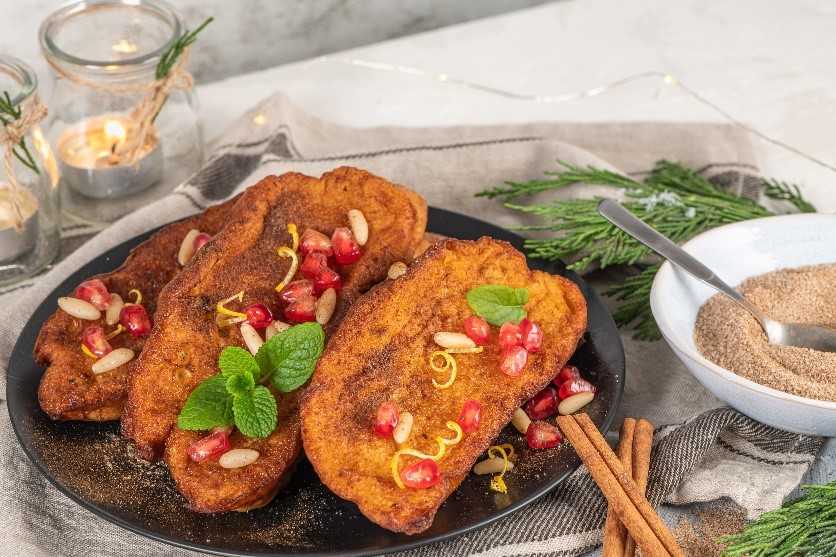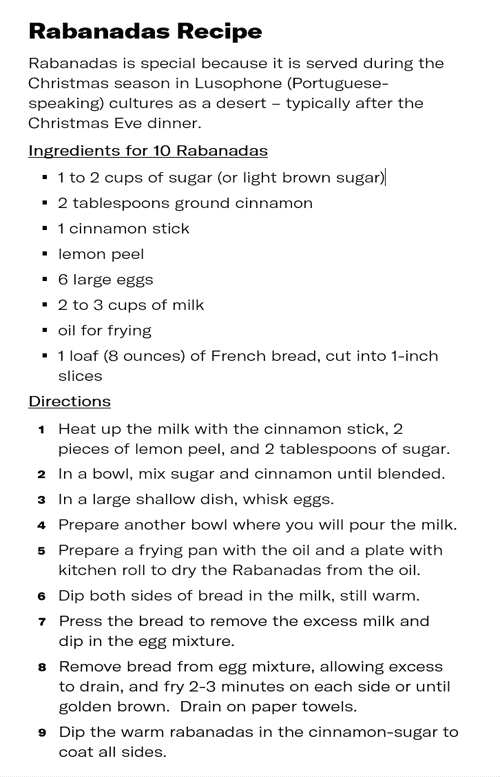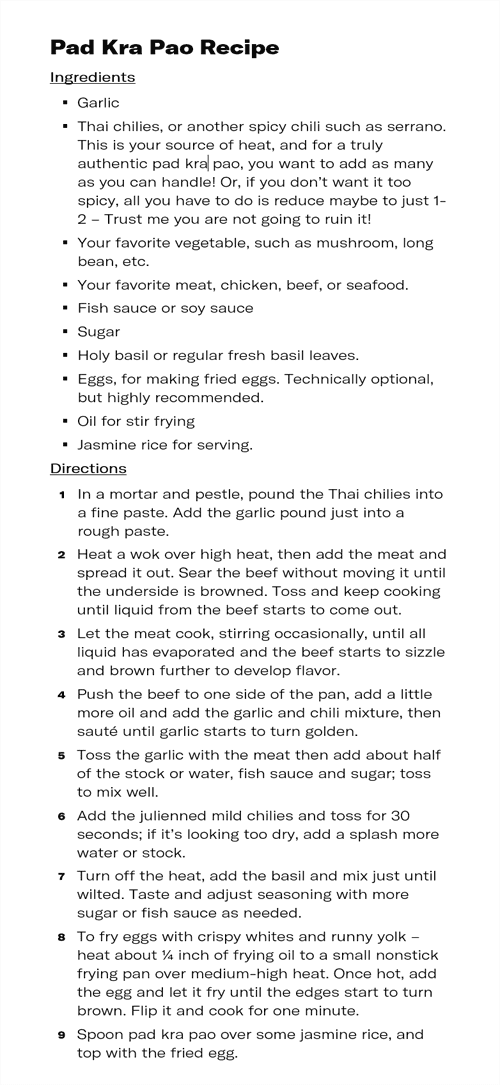
As 2022 comes to a close, we thought it would be fun to share a few holiday traditions, recipes, and celebrations that take place all around the world. CIA’s Intelligence Language Institute asked our foreign language officers about holiday customs that are special to them. Here’s what they had to say.
* * * * *
Christmas in Peru
Peruvians celebrate Christmas on the 24th. Families will spend the evening together until it’s time to say “Feliz Navidad!” at midnight. Then we hug each other and it is very special to share that moment with friends and family. It usually results in tears. For many, it is the time to tell our siblings and parents how much we love them and to ask for forgiveness for something that we may have done wrong or simply give thanks. We also make a toast with champagne and say a small prayer in front of the nativity.
After that, we open presents and have Christmas dinner (usually around 12:30am) and eat turkey. For dessert, we drink chocolate and eat paneton.
Fritule from Croatia
Fritule are a traditional Croatian version of a fritter, similar to a doughnut hole. They are very popular around Christmas time and carnival season as they were specifically created to be a festive treat. While fritule originated in Dalmatia, Croatia, it is enjoyed all over the country.
The dough’s main ingredients are flour, eggs, yeast, milk, butter, sugar, yogurt, and baking powder. The aroma from fritule is usually very strong – full of vanilla, citrus, and the secret ingredient, brandy. The dough can be made from three different doughs – yeasted dough, dough leavened with baking powder, or choux pastry. Additional ingredients can vary depending on preference. You can add lemon zest, orange zest, raisins, grated apples, vanilla, pine nuts, or even walnuts.
Once the dough is complete, it’s time to shape and cook. The rule of thumb is to make a circle with your thumb and pointer finger and push dough through. That will give you the typical size for fritule. The fritule then goes into very hot oil to fry, and once cooked thoroughly, coat them in sugar. They can be served with your choice of fruit jam, chocolate, caramel, or simply dusted with powdered sugar.
Ukrainian Christmas (Rizdvo)
Rizdvo, starts with a Holy Evening, Svyatvechir, where 12 traditional dishes are served. The Holy Evening starts when the first star, Zorya, appears in the sky. The family gathers around the table to honor their ancestors and thank their land for the year’s generous harvest. The centerpiece of the dinner table is called Grandfather’s Spirit, or “Didukh,” in Ukrainian and is made from a sheaf of woven grain and dried herbs and flowers that represent the importance of wheat crops in Ukraine. After dinner, people sing carols and perform little outdoor plays called “Vertep.”
Did You Know: The famous holiday song, “Carol of the Bells,” was written by a Ukrainian composer, Mykola Leontovych, in 1916. It is called “Shchedryk” in Ukrainian, which means “generous” or “bountiful.”
Holiday Season in the Lusophone (Portuguese-speaking) World
At this time of the year, Christians in the Lusophone world may have nativity scenes (crèches) and Christmas trees, and they exchange gifts either after Midnight Mass (Missa do Galo) or on Christmas day. During the holiday season (quadra natalícia), most towns are decorated with lights. The festivities end on January 6, known as Day of the Kings (Dia de Reis).
On Christmas Eve, in most parts of the Lusophone world, dinner (consoada) consists of codfish with boiled potatoes and cabbage. After the meal, people eat traditional fried desserts: filhoses or filhós are made of fried pumpkin dough; rabanadas are similar to French toast; azevias are round cakes made of a crust filled with a mixture of beans or chick peas, almonds, fig-leaf squash, sugar, and orange peel; aletria is a vermicelli sweet of Islamic origin made with eggs.


A Brazilian New Year’s Eve: “Ano novo, vida nova!” (New year, new life!)
Generally, Brazilians are superstitious when it comes to New Year’s Eve traditions. For example:
- At the beach, if one jumps through seven waves as the clock strikes midnight and makes a wish at each jump; the wishes will come true.
- Wear white on New Year’s Eve, with a touch of color to attract what you wish (e.g. blue for tranquility and friendship, purple for inspiration).
- Eat lentils, for they bring luck; and pomegranates, as they bring wealth.
- Do not eat poultry – these animals walk backward and represent a regression in life.
- Carry a bay leaf in your pocket for good omen in the new year.
Pad Kra Pao from Thailand
Pad Kra Pao is a Thai stir-fry dish of meat, holy basil, and loads of chilies. It’s served on rice, and usually with a fried egg on top.
I think deserves the title, “National dish of Thailand.” It’s a favorite of Thai people and Thai food lovers around the world. This dish is simple yet very special because it fits in every season!
Most of the street vendors around Thailand will serve Pad Kra Pao as it is a very popular lunchtime dish. It is a joke among Thai people that when you don’t know what to eat, Pad Kra Pao always comes up on your list.
I am one of many Thai people that love this dish. I love it so much that I can literally eat it every day. I have a fond memory with this dish as Pad Kra Pao is one of my first few dishes when I started to learn how to cook.


New Year’s Eve in Indonesia
In Indonesia, trumpets have become synonymous with New Year’s Eve. Along with the sounds of fireworks going up into the sky, all around you will hear the sound of trumpets. For decades, Indonesians have used trumpets made from card box paper. They are so popular that roadside trumpet sellers begin to sell their wares in mid-December.
While waiting for midnight, Indonesian people generally prepare BBQ dishes or other items that can be easily grilled on an open fire such as corn and chicken. They will pamper their stomachs with delicious food while waiting for the big countdown.
Russian Christmas and New Year
Since 1992, Christmas has become a national holiday in Russia and it is celebrated according to the Julian calendar used by the church. The Russian New Year (31 December) is a very special holiday widely celebrated in Russia and all post-Soviet countries. Main dishes on the table include a variety of pork, roasted duck, meat, jelly (kholodets), stuffed cabbage, salad Olivier, many appetizers, and plenty of drinks (of course Vodka and Champagne). People watch festive programs on TV, and visit friends and family.
They wish each other “S Novim Godom” (Happy New Year!) and “S Rozhdestvom” (Merry Christmas!)
Sul Naal, a Korean New Year Holiday
Sul Naal is what we think of as New Year’s Day in Korean cultures. It is often celebrated by greeting ancestors through ancestral rites and bowing to elders. Families exchange words of blessing and wishes of good luck for the new year. Koreans enjoy the seasonal customs of New Year’s Day, such as eating exquisite traditional dishes, visiting ancestors’ graves, and playing seasonal folk games.
